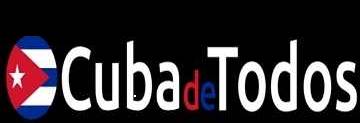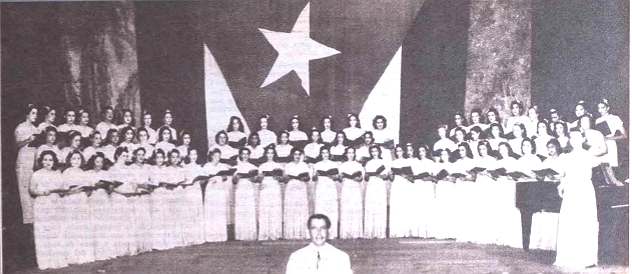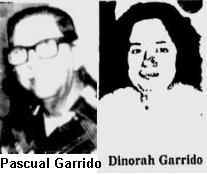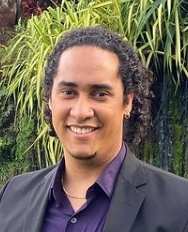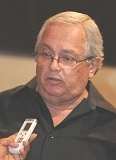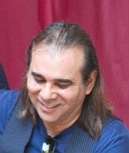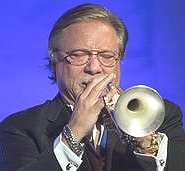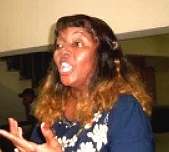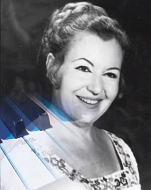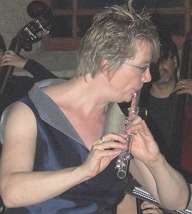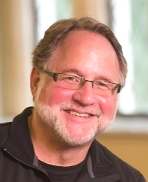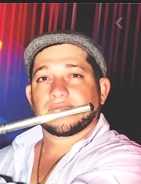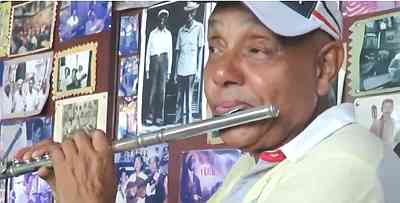Whole story of the Symphony Orchestra of the Orient Cuba(OSO)
The whole story of the Symphony Orchestra of the Orient, Santiago de Cuba (OSO)
* Note: www.orquestasinfonicaoriente.com is a non-institutional Cuban website. Source of information: Internet.

Origin of the current Orchestra Symphony of Orient (OSO)
The current Orquesta Symphony of Orient (OSO) of Santiago de Cuba can be considered, in a certain way, as an "heir" to the previous existing symphony orchestra prior to the so-called "1959 Revolution".
The founder and first director of that Santiago de Cuba Symphony Orchestra was Antonio Serret (violinist), with 46 players (*).
The orchestra was made up, almost entirely, of graduates of the Eastern Provincial Conservatory, of which Antonio Serret was deputy conductor. “In memoriam. El maestro Antonio Serret”. Bohemia (La Habana) 63(23): 101-102; 4 jun., 1971.
The Historical Archive of Santiago de Cuba contains documents related to the founding of this orchestra, as well as the following list of its founding members:
That old Santiago de Cuba Philharmonic Orchestra had a recognized and successful journey as a Philharmonic Orchestra for two decades: the 40s and 50s of the 20th century.
Investigating a little in the archives and documents of the time prior to the violent and bloody takeover of Castro's power in 1959, it has been possible to prove that the "Philharmonic of the East" has been found since the early years of the 1940s XX (**) until 1959, associating it with abundant artistic successes (***).
The Philharmonic Society, for three decades, was the great catalyst of the musical and artistic culture of Santiago de Cuba
The so-called "Philharmonic Society of Santiago de Cuba", organized around 1929, scheduled numerous concerts and recitals each season. The Society was founded by Corina Mestre de Arango, and years later it was chaired by Dulce María Serret (great pianist and teacher) See next image:

(Extracted from: Facetas de la vida de Cuba republicana, 1902-1952. Volume 13 of Cuban and American Historical Collection. Cuban and American History: 13. Author Havana (Cuba). Office of the City Historian. Editor Emilio Roig de Leuchsenring Editor Office of the Historian, 1954. (page 93 of 380 pages)
To get an idea of the musical artistic level reached in Santiago de Cuba, we cannot fail to insert the following literal quote from: Center for Scientific and Technical Information, University of Havana (****):
The aforementioned Philharmonic Society of Santiago de Cuba opened its stages to leading figures in the international arena. Pianists such as Hector Ruiz Díaz (Argentine), Dulce Máría Serret, Artur Rubinstein, Rudolf Firkusny, Nikita Magaloff, Benno Moissevitch, Witold Malcuzinsky, Jorge Bolet, José Echániz, José Iturbi, and David Eicourt were heard; violinists Mischa Elman, Jascha Heifetz, Henry Szering, and Isaac Stern; guitarists Andrés Segovia and Juan Antonio Mercadal, and in the 1949-1950 season the opera by Wolfgang Amadeus Mozart, Las Bodas de Figaro was heard with a cast from the Metropolin Opera House in New York. Coinciding with the creation of the Philharmonic Society, the National Art Congress is held, organized by the Conservatory, which was attended by composers Alejandro García Caturla and Eduardo Sánchez de Fuentes
The Philharmonic Society maintained, with great success by the way, the Santiago de Cuba Philharmonic Orchestra, directed from its beginnings by Antonio Serret (it already appears in the census of Cuban orchestras in 1943). In addition to the Symphony, Maestro Serret also directed the Choral Society of the Santiago Conservatory (image: A. Serret conducts the choir ) mouse over the photo to enlarge it.
mouse over the photo to enlarge it.
On the other hand, Antonio Serret was also deputy director and professor of theoretical subjects at the Provincial Conservatory of Music of Santiago (today called "Esteban Salas"). Antonio Serret began to exercise the position of deputy director of the Conservatory after the death, on May 4, 1928, of Ramón Figueroa Morales, deputy director of the latter since its inception in 1927. (Calero Martín, José and Leopoldo Valdés Quesada. Cuba Musical. LaHavana: Imprenta de Molina y Compañía, 1929. page 54).
It is worth mentioning that in 1947 Maestro Serret was awarded the Carlos Manuel de Céspedes decoration, as was his sister Dulce María, the director of the Conservatory.
Creation of the Provincial Conservatory of the East (Santiago de Cuba)
The Provincial Conservatory of Santiago de Cuba was created by order of the Governor of the eastern province, Mr. José Rafael Barceló Reyes in the month of February 1927 (******), "being inaugurated on September 24 of said year with 240 students of both sexes, exceeding this number to the most optimistic calculations, since it was believed that they would not exceed one hundred and that it would be difficult, with the amount of tuition, to cover the investment of twelve thousand pesos (including the installation costs that amounted to four thousand). But not only did the total investment cover tuition, but it also made it possible to increase the number of teachers to six "(Musicalia, No. 2, Sociedad Coral de La Habana, 1928; p. 53).
The Director of the Provincial Conservatory of Music of the East was from its beginnings (inaugurated on 09-24-1927), Dulce Maria Serret (03 23, 1898-May 30, 1989) (Antonio Serret's sister). In 1928 the Conservatory was endowed with an annexed School of Singing and Declamation. "This Eastern Provincial Music Conservatory continued to function until the 1966/1967 academic year. This past year the Centro Popullar de Música was created, which later took the name of Lauro Fuentes Vocational School of Music, and in which Dulce María Serret occupied the leadership, until his death, of the piano chair "(*****)
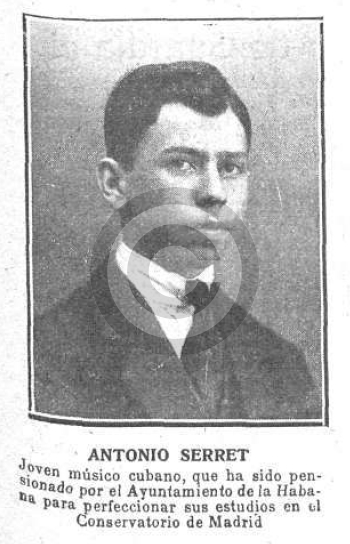
NOTE: The illustrated Spanish magazine MUNDO GRAFICO in its nº 246, p. 7, of July 12, 1916, published the following news: "ANTONIO SERRET, a young Cuban musician, who has received a pension from the Havana City Council to perfect his studies at the Madrid Conservatory."
NOTE: On July 15, 1926 Antonio performed with his sister Dulce María at the Teatro Oriente in Santiago de Cuba. Both were friends of the Cuban composer Alejandro García Caturla.
NOTE: A. Serret. In collaboration with Max Henríquez Ureña, he published in 1929, in Santiago de Cuba the book: "Elemental Treaty of Music" (more info about the book here) {/ tip} to also serve as a textbook.
News and "program" of the 1954 Christmas concert of the Santiago Philharmonic Orchestra

(Fuente: Boletín de Música y Artes Visuales, año 1954; pág. 7)
The Symphonic Orchestra (Philharmonic) of Santiago de Cuba, directed by Antonio Serret reaped great successes until 1959, the year that was dissolved as a result of the so-called "Cuban Revolution"
There are countless personal testimonies and references in books, yearbooks, newspapers and magazines of the time that confirm that the Symphonic Orchestra of Santiago de Cuba (also called "Philharmonic") was supported by the Philharmonic Society of Santiago de Cuba and that it earned a deserved prestige among Santiago society.
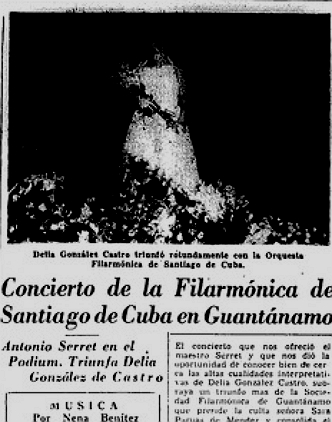
Outstanding soloists, instrumentalists and singers of the time participated supported by the Philharmonic Orchestra of Santiago de Cuba.

Fuente: "La última noche que pasé contigo", pág. 286; Bobby Collazo; Ed. Cubanacan, 1987
We will mention only a few soloists who performed with the Philharmonic Orchestra, until 1959:
- Baserva Soler (pianista) (exiled to the USA, 1960) ( (audio interview with Baserva)
- Marcelino (Pérez) del Llano (tenor singer)
- Dulce María Serret (pianist)
- Raque Salas (singer)
- Dinora Goderich (singer)
- Carmela de León, "la soprano del oriente" (soprano singer)
- Delia González de Castro (singer)
- Margot de Blanck (pianist) (27-05-1947)( {tip title="Fuente info" content="Informaciones culturales: boletín del Negociado de Relaciones Culturales, Volumen 1,Número 1 -Volumen 2,Número 9, pág.45."}(More info from the source))
- Pascual Garrido (cantante) ((view photo))
- Dinorah Garrido (singer)</>
The Philharmonic Society, witness to the cultural development of Santiago and other Cuban provinces
The church of San Francisco de Asís was one of the stages of concerts of sacred music, on Good Friday and in the Fiestas de Santa
Cecilia, Patron Saint of Music, days associated with the unforgettable names of the brothers Dulce María and Antonio Serret and the Reverend Father Paul
Ignacio Maestro Juan with the Choir and the Philharmonic Orchestra of the Eastern Provincial Conservatory; concerts that were commonly broadcast by the Provincial Radio Network, as has been testified in the press of the time (Words of Father Jorge Catasús, when presenting the Cuban Mass to the Virgin of Charity, by José María Vitier, in the Sanctuary of El Cobre, on January 26, 2007)
The church of San Francisco de Asís served as the stage, from 1941, to the celebration of a sacred concert, in commemoration of Good Friday, under the auspices of the Philharmonic Society of Santiago de Cuba and the Choral Society, both directed by the brothers Dulce María Serret and Antonio Serret, this being the first time that a similar act was held in Santiago de Cuba (Diario de Cuba, Wednesday, April 9, 1941).
In other provinces, such as the specific case of Guantánamo, where the Santiaguera Orchestra conducted by maestro Serret, obtained a resounding success for its concert, accompanied by the pianist Delia Gonzáles Castro on February 3, 1950 at the América theater, with the title of the news in the Diario de la Marina (page 16) Diario de la marina, the following day: Antonio Serret on the podium. In Banes (Holguín), the Orchestra directed by Serret starred in a memorable concert sponsored by the Banes College of Music Professionals.
In addition, there are abundant written and oral sources that attest to the celebration of important concerts performed by the then known as Orquesta Sinfónica de Oriente or Philharmonic de Santiago de Cuba directed by Antonio Serret (***), until the orchestra was dissolved in the year 1959 (in my opinion, unfairly treated by Fidel Castro), as a result of the "Cuban revolution" and the seizure of political power by Fidel Castro.
Three years after the Santiago Symphony was dissolved, a small concert orchestra was founded by mandate of Fidel Castro, which gave rise to the current OSO
After overcoming the 1959 war and after three years without a symphony orchestra in Santiago de Cuba, on March 1, 1962, the small Concert Orchestra of Santiago de Cuba was founded by Fidel's mandate Castro; as well as other similar ones were founded in other Cuban provinces. In some more Cuban provinces, in addition to the case of Santiago de Cuba, new symphony orchestras were refounded since the previously existing orchestras had disappeared as a result of the 1959 war.
Focusing on the current OSO, its first concert as a refounded orchestra took place at the "Mariana Grajales" Theater of the Old Moncada Barracks, city of Santiago de Cuba, on July 21, 1962, being then only a small concert orchestra of 32 teachers under the baton of the refounder, Vicente Bartutis Coello . A part of the members of the new Symphony came from the previous dissolved Eastern Philharmonic; but new musicians were also incorporated, such as the case of Osmundo Calzado Samada {/ tip} (from 1963 to 1967 ) (clarinetist and saxophonist). & nbsp; Among the members were: Ventura Calzado González (flute, clarinet); Daniel Guzmán Loizaga; Pascual Olivan E. (cello); Electo Rosell Horrutiner "Chepín" (violin).
The Orchestra's objectives
The main artistic objective in the creation of the new OSO was to bring to the people of the eastern provinces of Cuba the knowledge of the most refined symphonic art of the Cuban and universal repertoire for the satisfaction of their spiritual needs and the elevation of their cultural level.
Currently, the Orquesta Sinfónica de Oriente is the Insignia Musical Institution of the city of Santiago de Cuba. It has more than 60 professional interpreters and a history of more than four decades of existence as a refounded symphony orchestra, but still preserving the freshness of its beginnings. The OSO continues to be successful year after year and is admired by all who love the symphonic genre.
Refounding Director of the OSO: Vicente Bartutis Coello
Small biography of Vicente Bartutis Coello.
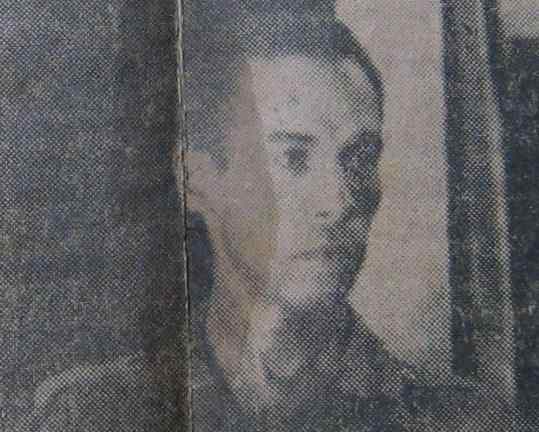
Flute player, orchestra director and composer. Sagua de Tánamo, Holguín, Oriente December 9, 1935.
Bartulis began his musical studies in 1940 with Nolín Riverí and continued with Cándido Álvarez on the flute.
After the revolutionary triumph of 1959, Bartulis joined as a flutist in the Rebel Army General Staff Band. During this time he took an orchestral conducting course with Manuel Dúchense Cuzán and Roberto Valdés Arnau and began directing the Camagüey Army Corps Band and then the Army Band of Santiago de Cuba.
In 1962, Maestro Bartulis directed the Orquesta de Concerto de Oriente - which later became the Orquesta Sinfónica de Oriente - at the head of which he spent more than a decade. Bartutis conducted his first concert in July 1962, at the María Grajales theater in the old Moncada barracks (later the headquarters of Tele Rebelde and today Tele Turquino).
Headquarters of the OSO Symphony Orchestra
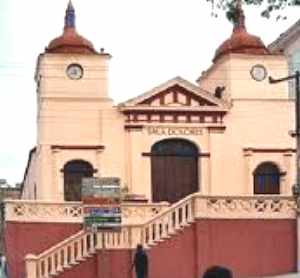
Its current headquarters is the Dolores Concert Hall in Santiago de Cuba (former church of the Dolores).
It is located in the downtown area of the city of Santiago de Cuba, within the José María Heredia People's Council, on Calle Aguilera on the corner of Reloj.
It was inaugurated precisely by the Orquesta Sinfónica de Oriente on January 1, 1989 under the baton of Frank Fernádez. Since then he has appeared in concerts in this Hall periodically, normally every 15 days, with various programs. The concert season begins each year in September and ends at the end of July.
Historically, the first rehearsal room for the orchestra was the birthplace of the poet José María Heredia. Later, the rehearsals were held at the Casa de la Música, at number 473 on Calle San Gerónimo. Later, in Calle San Pedro, between Santa Rita and San Carlos, passing these later to the Oriente Theater. Finally, since 1989, its headquarters is the "Dolores" Concert Hall, one of the most important and best in the country for this type of music.
The repertoire of the Orquesta Sinfónica de Oriente
The repertoire of the Orquesta Sinfónica de Oriente currently includes works that go through baroque, classical and romantic styles, including contemporary works, emphasizing the dissemination of works by Latin American and Cuban authors.
Important releases of composers
The Orchestra of the East has made important premieres of Cuban and foreign composers, mentioning
composers like:
Harold Gramatges,
Alejandro Julián (Mexico),
Leo Brouwer,
Jorge Luis Pujals,
Carlos Ovidio Morales (Puerto Rico),
Conrado Monier
Melvin Rodríguez
Guido López Gavilán
Mateo Oliva Oliva (Mexico)
Rodulfo Vaillant
Daniel Guzmán, among others.
Regular Directors of the Santiago de Cuba Symphony Orchestra (OSO)
They have been the titular directors of the Orchestra Symfony of Orient in different stages of the Masters:
- Vicente Bartutis, (see biography)
- Gonzalo Romeu, (see biography)
- Enrique Castro,
- Santiago Fals Castillo, 1966-77(see biography) (ver video)
- Miguel del Castillo Clavel, 1991-
- Anarelys Garriga Sosa, 1988-1997 (see biography)
- Mónica Alvarado Calderón (2001-2002) (Ecuador), (ver biografía aquí) (Facebook)
- Daniel Guzmán Loyzaga (biography Ecured) ( o biografía en La Jiribilla) y
- Cosette Justo Valdés (desde abril 2010 a 2017). ( Biography ) ( Facebook )
- Yasvesti González González, (at present) and concertmaster of the groupy
The invited directors
Among the directors who have acted as guests at the head of the Orchestra are the Masters:
| Dayana García, | David de la Mora, |
| Cosette Justo Valdés, | Eduardo Ramos Saavedra, |
| Electo Silva Gaínza, | Enrique González Manticci, |
| Enrique Pardo, | Enrique Pérez Mesa, |
| Julio Gonzalo Elias Roig Lobo, | Guido López Gavilán, |
| Helena Herrera, | Irina Guerra Lig-Long, |
| Irina Toledo Rocha,(Villa Clara)(23-4-2016) | Jorge López Marín,(14-102015)(dic 2014) |
| Jorge Luis Betancourt, | Jorge Rivero Tirado, |
| Juan Jorge Junco, | Leo Brouwer, |
| Manuel Dúchense Cuzán, | María Elena Mendiola, |
| Miguel Fortín, | Miguel García Oliva, |
| Norman Adolfo Milanés, | Orestes Saavedra |
| Rodrigo Prats, | Zenaida Romeu, |
| Yeny Delgado Rolo, | Akin Benatia (Argelia), |
| Alexander Frolov (Rusia), | Alexander Mijailov (Rusia), |
| Antonio Moya (España), | Alejandro Julián Pérez (México), |
| Benjamin Steinberg (EUA), | Bernard Rubenstein (EUA), |
| Eduardo Kusnir (Argentina), | Eduardo Moubarak (Chile), |
| Stefano Mazzoleni (Italia), | Francesco Belli (Italia), |
| Guillermo Villarreal (México), | Hilda Pous (México), |
| Guido Alfonso Medina Rivera, | Eduardo Díaz Rodríguez(20-5-2010) Salón los Vitrales |
| Horacio Azcárate (España), | Jaime Braude (Argentina), |
| Juan Luis González Delgado (España), | Jans Joachin Reeps (Suecia), |
| Jean Paul Penin (Francia), | Julius Karr-Bertoli (Suiza), |
| Mario Rodríguez Taboada (México), | Mijail Katanaf (Rusia), |
| Pablo Alvarado (Chile), | Refmir Borissowich (Rusia), |
| Valter Sivilotti (Italia), | Yoshikasho Fukumura (Japón), |
| Marc Moncusí (Reus, España) | Felipe Aguirre (Colombia)más info |
| Victor Vargas Ramírez(08-10-2017)(9-2-2019) | Stefano Mazzoleni (Italia) |
| Marco Tulio Niño Wong | Roberto Valera |
| Louis Franz Aguirre (nov-2018) | Jorge Gustavo Mejia Medina (Honduras) |
| Greta Perón Hernández | Gregorio Gutiérrez (9-abr 2016) (España) |
| Roberto Sánchez Ferrer | Frank Fernández Tamayo |
| Jorge Luis Prats Soca | Patricio Malcom |
| Evelio Tieles Ferrer | Cecilio Tieles Ferrer |
| Jennifer Almeida Vidal | Lee Bracegirdle (Australia) |
| Luis Aguirre | Víctor Pellegrini (Argentina) |
| Yarineidis Llinse Kessell | Michael Elvermann (Alemania) |
| Christopher Mina Díaz (Ecuador) | Leonardo Gell |
| Rubén Capriles (Venezuela)(biography) | Igor Ernesto Corcuera Cácerez (2019). |
| Tydo Dejan, | Martín Piecuch (EUA, jun-2018) |
| Alfonso López Chollett, (Venezuela) | ,Francisco Salvador Ulloa Anasco (wetween 1982 and 1983) |
| , | |
| Jessica Rivero (9-2-2019) |
strong>Prestigious soloists of the OSO
Prestigious soloists of recognized national and international prestige have performed with the Orquesta Sinfónica de Oriente, among which we can highlight the following:
{tip image="https://www.orquestasinfonicaoriente.com/images/adonis_gonzalez.jpg" image_alt="Adonis González" image_width="135" image_height="200"}Adonis González (piano), Alex Bravo (violín), Alfredo Muñoz (violín), Aquiles Jorge Rabaud (guitarra), Arturo Sandoval (trompeta, piano), Ángela Cristina Delisle Rodríguez (canto lirico), Daniel Vázquez, Enrique Navarro, Evelio Tieles, François Dolmetsch (Inglaterra), Fernando Godínez, Frank Fernández (piano), Frank Berenguer, Gerardo Alfonso, Huberal Herrera, Hugo Marcos Rodríguez Martínez, Hussan El- Kutob, Igor Frolov (Rusia), Ivette Hernández (piano), Salvador Pedraza (en 1998) (contrabajo), Jorge Luis Prats, Jorge Luis Zamora, Jorge Rivero Tirado, Giselle Lage Gil (cantante)(9-2-2019), Zulema Iglesias (cantante) 9-2-2019), José Aquiles, Juan Jorge Junco, Katheleen MacIntosh (Estados Unidos), Leo Brouwer, Leonardo Gell, Luis Rojas, Lleliandra González, Rafael Durán Herrera (fagot), Marco Tulio Niño Wong, Mari Kodama (Japón), María Remolá (soprano), María Isabel Prado, Mailyn Sevila, María Victoria del Collado, José Ernesto González (violista y violinista), Mario Orlando El-Fakih, Michael Elvermann (clarinete)(Alemania, clarinetista), Miguel Cintra, Miguel Villafruela, Omara Portuondo, Raúl Camayd, Raúl Estevanell, Rey Guerra, Flores Chaviano (guitarra), Roberto Valdés, Alejandro Saúl Martínez González (cello), Rodrigo González Barragán (México), Sara González, Sarah Hechavarría, Sergio Trujillo, Silvio Rodríguez Cárdenas, Teresita Junco, Victor Pellegrini, guitarra (Argentina), Victor Rodríguez, Yasvetty González, Zenaida Manfugás (piano), Magela Oquendo Romero (guitarra), Javier Orozco, Mayda Galano Guilarte (canto,,soprano), Maité Aboy González (píano) (29-5-2010), Javier Cantillo Laffita (5-mayo 2013) (violin), Glenda Grau Pardo, (piano) (2016), Karla Martínez (pianista cubana), Darío Antonio Martín García (Darío Martín) (pianista), Liana María Fernández Neira (piano), Annia Castillo, Villa Clara (piano) (23-4-2016), Martin Camacho (México)(2016 y 2017), Rubén González Ávila (guitarrista),Antipe Da Stella (6-5-2017) (flauta, Suiza), Mike Davison (13-5-2017) (trompeta) (EEUU), Iván Acosta (flauta) (6-may 2017), Enrique Navarro Acosta (flauta) (6-5-2017), Liuba María Hevia (dir.: Enr. Pérez Mesa;12-sep-2019?), Ildefonso Acosta Escobar (guitarrista y compositor), Rafael L. Inciarte Rodríguez (clarinete ), Lleliandra González Bárzaga (guitarra), David de la Mora (viola), Gabriela Nardo López (cellista, jun-2018)), Maikel González (trompetista, enero-2018), Bárbara Hendricks .3-2015 (messosoprano,EEUU), Ana Häsler (mezzosoprano; 18 y 19 oct-1014) , Igor Ávila Soria (guitarra), María Angeles Horta Hernández (piano), Humberto Rios (piano), Jorge Julio González (oct 2015) (Saxofón) y muchos otros más.
Development of the OSO for 58 years
The Orquesta Sinfónica de Oriente (OSO) of Santiago de Cuba is celebrating the 58th anniversary of its creation in 2017 . Watch this video related to the 55th anniversary.
To date, the Orquesta Sinfónica de Oriente has made nearly three thousand presentations in the most recognized in the country, in cultural centers, in study centers, in factories, plazas and theaters.
The OSO has offered concerts in numerous towns and cities of almost all the provinces of the nation, mainly in the eastern provinces of Cuba.
In addition to its performances in regular concert seasons, the OSO has also carried out programs and recordings for Radio and TV, as well as recordings for the Siboney label of the EGREM in Santiago de Cuba.
The OSO has participated in numerous festivals and events such as:
International Festival of Lyrical Art of Havana.
Seasons of Operas and Zarzuelas with soloists of the National Opera, with the Lyrical Study of Holguín and soloists from different countries.
International Guitar Festival of Havana.
Several editions of the International Choir Festival in Santiago de Cuba.
Different editions of the Caribbean Festival.
International Festival of Contemporary Music of Havana.
Romerías de Mayo in the city of Holguín Several editions of the Fiesta de la Cubanía in the city of Bayamo.
Musical Days of the UNEAC.
Concert Santiago. International Ballet Festival of Havana at the National Theater of Cuba in 2006.
National Meetings of Symphonic Orchestras held at the Amadeo Roldán Auditorium Theater in the City of Havana.
Infinity of national and international cultural events that have been held in Santiago de Cuba.
--------------------------------------------
--------------------------------------------
(*)Según ESPINOSA, Guillermo. (junio 1954). DIRECTORIO MUSICAL DE LA AMÉRICA LATINA: CONSERVATORIOS, ACADEMIAS Y ESCUELAS DE MÚSICA Y ORQUESTAS SINFÓNICAS. Unión Panamericana. Washingtong, en la pag. 25 se relaciona que Santiago de Cuba se desarrollaba:
ORQUESTA FILARMÓNICA DE SANTIAGO DE CUBA,
Pío Rosado 461
Director: Antonio Serret
46 ejecutantes
( * *) "Santiago de Cuba que siempre ha estado a la cabeza de los esfuerzos para hacer buena música contaba con una orquesta sinfónica dirigida por Antonio Serret" (PÉREZ SANJURJO,E. 1986. Historia de la Música Cubana. Miami: Moderna Poesía.)
(***) "No podemos dejar de consignar los éxitos brillantes que durante este año ha alcanzado la Orquesta Filarmónica de Santiago de Cuba bajo dirección de Antonio Serret, alcanzando alto nivel artístico..." (Anuario EL País, año 1947, p.176)
(****)Según Centro de Informacion Cientifica y Tecnica, Universidad de la Habana, 1997. Universidad de la Habana, Número 247; pag.212
(*****) Según Gaceta Musical, Volumen 1, Números 1-12, Manuel María Ponce, Centro Nacional de Investigación, Documentación e Información Musical Carlos Chávez. CENIDIM, 1928, pág. 40

